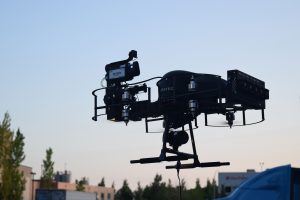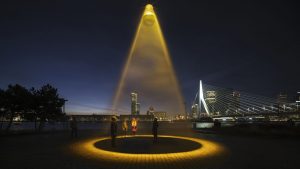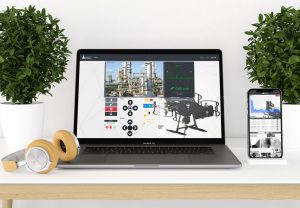New intelligent robotic drone technology from a Canadian technology company is being used to inspect hazardous industrial workplaces and protect workers in various industries, such as oil, gas, and mining.
The same robot drone tech could be used to disinfect indoor environments and reduce the community spread of viral agents, including COVID-19, as a way to protect us all.
These are some of the latest applications to emerge from what’s called the inspection robot market, a growing tech sector that integrates aerial, tethered and autonomous drones and robotic vehicles; infrared and other sensing devices; spatial and interactive controls; machine learning and artificial intelligence capabilities, and more. According to industry analysis, the global inspection robot market was valued at $938.5 million (USD) in 2020. The market is forecast to grow at some 30 per cent through 2027.

Avestec’s Skyron is a robotic tethered drone used for non-destructive industrial testing and inspection. Avestec image.
Avestec Technologies Inc., a Canadian tech company based in Burnaby, B.C., is well-positioned to take advantage of that growth, having just been recognized with an industry award for its flying robot, known as Skyron.
The Clean Resource Innovation Network recognized Avestec for developing tethered flying robots for the inspection of industrial spaces in various natural resource industries.
Drone-based inspection can be controlled remotely using integrated software tools and dashboards.
“For years, the inspection of industrial, hard-to-reach spaces has been unsafe, expensive and time-consuming,” a CRIN statement read. “Within this context, intelligent robotic inspection emerges as a revolutionary technology that provides accurate contact-based inspection to fulfill industrial inspection standards.”
And save lives.
Hazardous industrial spaces (e.g., confined spaces) are among the most challenging and costly areas to inspect. In B.C. alone, over the last decade, WorksafeBC reported about 18 fatalities per year as the result of operation in confined spaces. To mitigate the risks, remote monitoring and inspection is now offering an attractive alternative to conventional methods.
But it’s a design and development project being run by Avestec and its partners at the University of British Columbia that holds attractive alternatives to conventional disinfecting of public environments.
The team is working on a hybrid aerial and ground robotic solution for environmental disinfection and surface sanitation using ultra-violet radiation.
It could reduce and limit the spread of pathogens such as COVID-19.
Faculty supervisors and project interns in the Department of Electrical and Computer report they intend to take advantage of autonomous aerial and ground solutions to improve the agility of the disinfection process of public environments.
They intend to design and develop unmanned aerial and ground vehicles capable of carrying UV emission devices that operate cooperatively and autonomously to disinfect indoor environments. Ultra-violet irradiation is described as a proven disinfection technology to inactivate microorganisms by damaging their DNA/RNA.
The goal is to significantly reduce the community spread of infectious agents like COVID-19 by increasing the frequency and efficiency of surface disinfection in high-risk public environments.
Other disinfectant techniques, not necessarily part of the Avestec/UBC project, include the spraying of an electrostatically charged mist onto surfaces and objects. The sprayer is electrically charged, allowing a specialized solution and disinfectants to evenly coat all types of surfaces to kill germs, bacteria, and different types of viruses.

An architectural firm in the Netherlands considers flooding entire city squares and outdoor sports areas with safe, germicidal ultraviolet light as part of its “Urban Sun” project. Studio Roosegaarde image.
And a light bath of 222 nm ultraviolet light, considered safe for both people and animals, is said to be able to reduce the corona virus up to 99.9 per cent.
While some have likened current pandemic responses as “hygiene theatre” saying attempts to thwart the disease are misguided or ill-informed, other see value above and beyond the current crisis.
Hospitals, grocery stores, public transportation vehicles and hubs, education setting and more are among the places where continuous cleaning of different surfaces is a good if not required idea, regardless of the targeted actors or potentially infectious agents. But current methods, like manual cleaning with disinfectant wipes, can put staff at risk, even though the cleaning itself can be somewhat limited in effectiveness.
From the hazardous industrial workplace to the safety confines of a public environment, the development of autonomous and tethered flying robots could not only help reduce time and cost of inspection but eliminate health hazards and risks to human operators and the public as well.

Drone-based inspections can be controlled and result monitored remotely using integrated software tools and dashboard interfaces. Avestec image.
-30-



